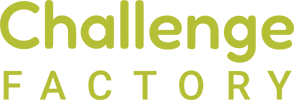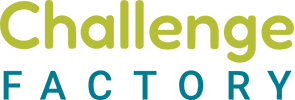Toss the crystal ball: Using story to set strategy








This Challenge Factory work advances the above UN Sustainable Development Goals.
We love telling stories here at Challenge Factory.
Strategic planning is often met with groans about Gantt charts and KPIs. To increase engagement in the process, we use innovative approaches grounded in strategic foresight methodology, like the story-based thought experiment below. These energize and activate organizations and their people beyond the planning process. Below the story, you’ll find a case study that connects the creativity of our approaches to the concrete business outcomes we help our clients reach.
Want to learn more? Contact us today.
Imagine that the following story is your story. It’s a story about yourself and your field. A story about your lived experience. Suspend your disbelief. Kickstart your imagination.
Surprise! You were frozen in carbonite in 2021 and have just been revived by researchers a hundred years later to tell your story.
Waking up from your long, dreamless sleep, you now have to adjust to life in 2121.
Before you can begin adjusting, however, the researchers tell you why they revived you. They hope to use you as a primary data source for their history project about work in the 21st century.
The researchers start by asking you questions about what you remember about the very beginnings of your field. You answer as feeling starts to return to your fingers and toes.
Next, they prompt you, “Now, we want to know what someone of your era thought about your own time and imagined the future would look like.”
The researchers ask you to imagine what you might have predicted, hoped for, or feared about the future of your field in 2021. “Consider what threats and what possibilities the immediate future held, and those that faced future generations, even us in the 22nd century.”
As you try your best to answer their questions, you wonder what could have been done in your own time to promote your dreams and combat your fears.
You don’t yet know what has happened during your long, cold slumber. You understand that you are providing rich data to your handlers, so you reflect thoughtfully. Your curiosity is piqued, and soon you’ll learn if any of your predictions came to pass.
Finally, the researchers stand up and set down their tablets. They offer their hands to shake.
“Thank you so much for this opportunity,” one researcher says.
“We really appreciate your insights,” another researcher says, leading you to the door. As they press their hand against a panel beside the door, it hisses and shoots up to reveal a pristine white hall beyond.
“You’re about to see how much you contributed to our history,” they say as you walk into the hall. “We’re fascinated to learn how you find the world of 2121.”
With that you walk down the hall and come to a wide window that looks out over a foreign yet familiar workplace…
You’ve just experienced a snippet of our Choose Your Challenge tool. Narrative approaches like this are just one of the methods we use to build buy-in and engagement on complex strategic planning issues. The case study below explores how our strategic foresight facilitation helps teams develop future scenarios that can determine priorities, sense market shifts before they happen, and identify unique opportunities to do things differently.
“My experience with Challenge Factory is that they take an iterative and creative approach to their work so that it doesn’t get locked into a particular methodology or set endpoint. If things change and new learnings emerge, they are nimble, flexible, and creative enough to shift and pivot as needed, which is so crucial in today’s world.”
Lisa has worked to enhance the capacity of me and my team through her individual interactions and workshops, but also in the way that she has conducted herself with humility, grace, and optimism. I truly appreciate that Lisa has acted as a positive force for reflection, as she looks to form connections and advance our individual and collective missions. Challenge Factory has led the members of my team in insightful discussions about our communication styles, driving forces, empathy quotients as well as practical considerations of engaging in difficult conversations and resolving conflict.
“The issues related to the Future of Work are both wide-ranging and complex. All Canadians – employers and employees – will benefit from the important work underway to envision a better, more productive workplace. Established consultancies have a role to play in all of this, but independent thinkers like Lisa are making important, outsized contributions.”
Case study: How Challenge Factory uses strategic foresight to empower future-focused institutions
The client:
- Post-secondary medical and research institution
The challenge:
- Typical strategic planning processes can’t anticipate global pandemics, wholesale shifts in how people work, the impact of climate change, or unpredictable supply chains and labour markets.
- Diverse and complex issues—from questions about workspace design to cross-faculty facilitation and alignment—can pull focus away from overall strategic planning efforts.
- Leadership teams need new tools, approaches, and cross-disciplinary supports that can help them create, communicate, implement, and measure the impact of future-focused strategies in an environment rife with uncertainty.
- Employees need to know how their work contributes to the overall success of their organization. Without this understanding, employee engagement, retention, and workplace culture all suffer.
Who we helped:
- The institution’s provosts, leadership teams, deans, faculty members and administrative staff
The solution:
Our client initially came to us for help answering the following types of questions: “What policies do we need to get through the pandemic?” “Should we force people to return to labs for courses that we’ve learned how to teach online?” “How do we navigate the politics of strong feelings on both sides of this shift in educational approach?”
These questions are very common. They speak to the institution’s deep commitment to creating great experiences in education for their employees and students. But answering these questions, and only these questions, often doesn’t solve underlying challenges or create future-focused organizations that are ready to shape their own Future of Work.
Creating the type of change and impact that this institution wanted meant aligning their core organizational values with the work and workplace experiences that their people have every day. It’s important to remember that culture is set from the top, but experienced in day-to-day interactions.
- We led senior leaders through a visioning activity that identified their core values and had them guide key decisions to address current uncertainty and disruption. We also grounded this process in what has made the institution successful in the past, creating a sense of control, predictability, and consistency that could be passed to all employees.
- We worked with department chairs and deans within the institution to uncover hidden needs, fears, and dreams for the future and tied them to concrete topics about careers, workspaces, engagement, and more. We used formal assessment tools as well as listening campaigns.
- We identified who across the complex institution needed to be part of the strategic planning process and facilitated bringing groups of people together who would normally do their planning on their own.
- We used strategic foresight techniques to identify various future scenarios that could be possible. With our guidance and facilitation, leaders gathered evidence to support selected scenarios, building roadmaps complete with hypotheses and success criteria to help navigate several possible paths.
- We supported the leadership teams as they developed a new type of strategic plan that emphasized culture, values, and workforce engagement to achieve institutional goals. This included creating infographics and other tools that made complex planning easy to communicate and understand.
- We provided individual and team coaching to create, implement, communicate, and navigate the change that comes with a new strategic plan to withstand extreme uncertainty and disruption.
The impact:
- Leadership teams across the institution are more collaborative than before.
- Uncertainty is met with tools rather than trepidation as organizational values, scenario planning, and rapid road-mapping have become core competencies within the leadership team.
- There is new capacity to respond to day-to-day crises, while also laying and reinforcing the foundation for significant long-term shifts in the role post-secondary education plays in the Future of Work. These now exist in tandem.
The next steps:
Challenge Factory remains a ‘behind the scenes’ advisor, source of tools, and support to senior leaders, frontline managers, and strategic working groups. We evolve how we work with this institution as their own capacity and needs change, making sure that the deep institutional knowledge that we’ve developed with them can remain accessible.
Learn more:
- Workforce Architecture article: “Asking better questions: A Culture Blueprint that works”
- Free tool: Pandemic policy decision tree
- Blog: “The most important question for returning to the office is not who, how, or when. Here’s why.”
- Blog: “The pandemic crisis management equation”
- Infographic and career development sector case study: “Write a letter to yourself—from the future”

